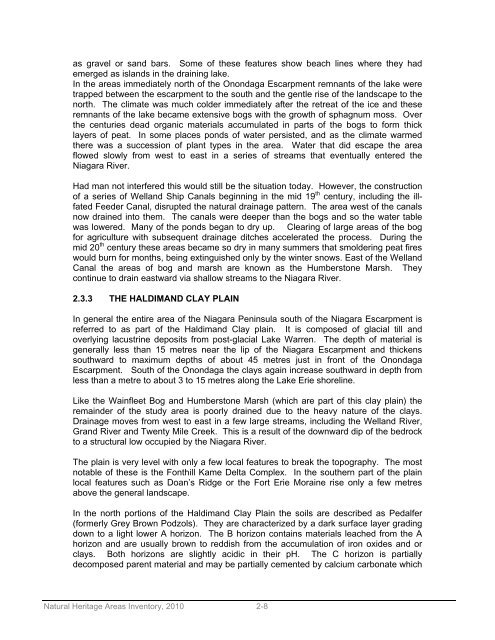2.0 Watershed Geologic Characterization.pdf - Niagara Peninsula ...
2.0 Watershed Geologic Characterization.pdf - Niagara Peninsula ...
2.0 Watershed Geologic Characterization.pdf - Niagara Peninsula ...
You also want an ePaper? Increase the reach of your titles
YUMPU automatically turns print PDFs into web optimized ePapers that Google loves.
as gravel or sand bars. Some of these features show beach lines where they had<br />
emerged as islands in the draining lake.<br />
In the areas immediately north of the Onondaga Escarpment remnants of the lake were<br />
trapped between the escarpment to the south and the gentle rise of the landscape to the<br />
north. The climate was much colder immediately after the retreat of the ice and these<br />
remnants of the lake became extensive bogs with the growth of sphagnum moss. Over<br />
the centuries dead organic materials accumulated in parts of the bogs to form thick<br />
layers of peat. In some places ponds of water persisted, and as the climate warmed<br />
there was a succession of plant types in the area. Water that did escape the area<br />
flowed slowly from west to east in a series of streams that eventually entered the<br />
<strong>Niagara</strong> River.<br />
Had man not interfered this would still be the situation today. However, the construction<br />
of a series of Welland Ship Canals beginning in the mid 19 th century, including the illfated<br />
Feeder Canal, disrupted the natural drainage pattern. The area west of the canals<br />
now drained into them. The canals were deeper than the bogs and so the water table<br />
was lowered. Many of the ponds began to dry up. Clearing of large areas of the bog<br />
for agriculture with subsequent drainage ditches accelerated the process. During the<br />
mid 20 th century these areas became so dry in many summers that smoldering peat fires<br />
would burn for months, being extinguished only by the winter snows. East of the Welland<br />
Canal the areas of bog and marsh are known as the Humberstone Marsh. They<br />
continue to drain eastward via shallow streams to the <strong>Niagara</strong> River.<br />
2.3.3 THE HALDIMAND CLAY PLAIN<br />
In general the entire area of the <strong>Niagara</strong> <strong>Peninsula</strong> south of the <strong>Niagara</strong> Escarpment is<br />
referred to as part of the Haldimand Clay plain. It is composed of glacial till and<br />
overlying lacustrine deposits from post-glacial Lake Warren. The depth of material is<br />
generally less than 15 metres near the lip of the <strong>Niagara</strong> Escarpment and thickens<br />
southward to maximum depths of about 45 metres just in front of the Onondaga<br />
Escarpment. South of the Onondaga the clays again increase southward in depth from<br />
less than a metre to about 3 to 15 metres along the Lake Erie shoreline.<br />
Like the Wainfleet Bog and Humberstone Marsh (which are part of this clay plain) the<br />
remainder of the study area is poorly drained due to the heavy nature of the clays.<br />
Drainage moves from west to east in a few large streams, including the Welland River,<br />
Grand River and Twenty Mile Creek. This is a result of the downward dip of the bedrock<br />
to a structural low occupied by the <strong>Niagara</strong> River.<br />
The plain is very level with only a few local features to break the topography. The most<br />
notable of these is the Fonthill Kame Delta Complex. In the southern part of the plain<br />
local features such as Doan’s Ridge or the Fort Erie Moraine rise only a few metres<br />
above the general landscape.<br />
In the north portions of the Haldimand Clay Plain the soils are described as Pedalfer<br />
(formerly Grey Brown Podzols). They are characterized by a dark surface layer grading<br />
down to a light lower A horizon. The B horizon contains materials leached from the A<br />
horizon and are usually brown to reddish from the accumulation of iron oxides and or<br />
clays. Both horizons are slightly acidic in their pH. The C horizon is partially<br />
decomposed parent material and may be partially cemented by calcium carbonate which<br />
Natural Heritage Areas Inventory, 2010 2-8

















